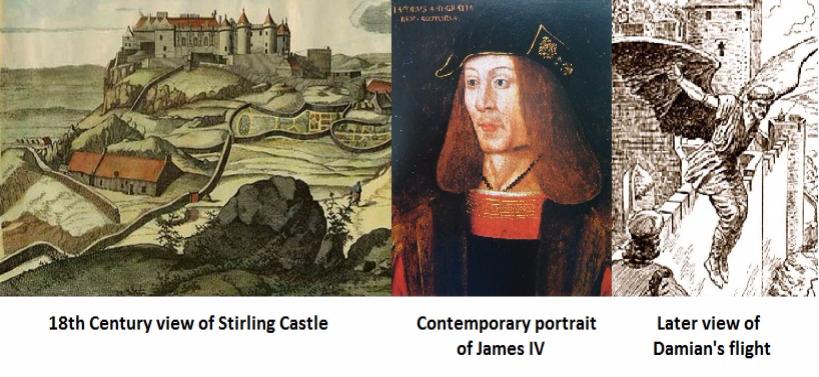THE SCOTTISH ICARUS - THE TALE OF JOHN DAMIAN
Sometime around 1500 a penniless Italian adventure arrived at the court of the Scottish King James IV. The man called himself, rather grandly, Giovanni Damiano de Falcucci but he’s better known as John Damian the Birdman of Stirling Castle. This highly plausible gentleman declared himself to be an alchemist who could transform base metal into gold and his claim certainly caught the attention of the king. Like most late medieval monarchs, James IV had a keen interest in the new arts and sciences of the Renaissance but, even more importantly, he needed lots of money to fight both the English and his own rebellious noblemen.
An inexhaustible supply of gold was definitely of interest to the cash-strapped monarch so Damian was appointed the king’s physician (or ‘leech’ in Old Scots) and allowed to build alchemical laboratories at both Stirling Castle and the Palace of Holyrood in Edinburgh. Royal accounts for 1503 show that Damian was given money to buy large quantities of alum, litharge, orpiment, quicksilver, sal ammoniac, saltpetre, silver, sugar, sulphur, tin, verdigris, vinegar and white lead for his experiments. Damian also supervised the royal entertainments and the accounts show that the king lost a great deal of money playing cards and betting on shooting competitions with his alchemist.
Though Damian was making plenty of money for himself he was producing very little gold for the king and the court gossips soon began to whisper that the king’s alchemist was a fraud. In spite of these rumours, James made his new favourite Abbot of Tongland but Damian’s continuing failure to produce the promised gold eventually became so incriminating he was forced to do something drastic to silence his critics. Fraud he may have been, but fearless he wasn’t, because in the autumn of 1507 John Damian declared he would fly to France using a pair of artificial wings he’d invented.
A few days later, the king and a crowd of chattering courtiers assembled on the battlements of Stirling Castle. With baited breath they watched Damian don the wings he’d made from feathers supplied by the royal poulterers. After saying a quick prayer, Damian climbed to the castle’s highest tower and leapt into the void. The result was somewhat predictable, the alchemist immediately plummeted to earth, but he was saved by a lucky landing in a dung heap. Though he broke his thighbone, and was forced to resign his lucrative abbotship, Damian survived and the records show that he was still gambling with the king right up until James’ death at the Battle of Flodden in 1513.
Damian’s less than successful flight might have been forgotten had it not been for the ‘makar’ (poet) William Dunbar who, ironically, was one of Damian’s fiercest critics. Though Damian isn’t named in Dunbar’s satirical poem ‘The False Friar of Tongland’, in which a ‘medicar in leech-craft’ fails to fly to France, has to be a thinly veiled reference to Damian. A later 16th Century chronicler, John Leslie Bishop of Ross, also tells the tale but he’s much kinder to his fellow churchman. Leslie claims that the flight only failed because Damian was forced to use chicken feathers when he couldn’t find enough of the eagle feathers he wanted!
In my own small way I like to think that I too have commemorated Scotland’s first pilot as John Damian is the inspiration for my fictitious alchemist and adventurer Thomas Devilstone, the hero of my book The Devil’s Band (to order click here) and if you’d like to read Dunbar’s poem in the original Lowland Scots click here
